Taxation Law: Application of Residency Tests and Income Assessment
VerifiedAdded on 2023/06/04
|13
|3198
|491
Homework Assignment
AI Summary
This assignment delves into various aspects of Australian taxation law, focusing on residency rules and income assessment. It analyzes scenarios involving individuals like Fred and Jenny to determine their residency status based on factors such as length of stay, intention, and connections to Australia. The assignment also examines different types of income, including salary, compensation, gifts, and proceeds from sales, to determine whether they are considered assessable income under the Income Tax Assessment Act (ITAA) 1997 and ITAA 1936. Furthermore, it covers allowable deductions for expenses such as electricity bills, home office expenses, and self-education costs, referencing relevant case laws to support the analysis. The computation of taxable income and net tax payable for an individual, Mick Viduka, is also demonstrated. The assignment concludes by discussing various scenarios related to deductions.
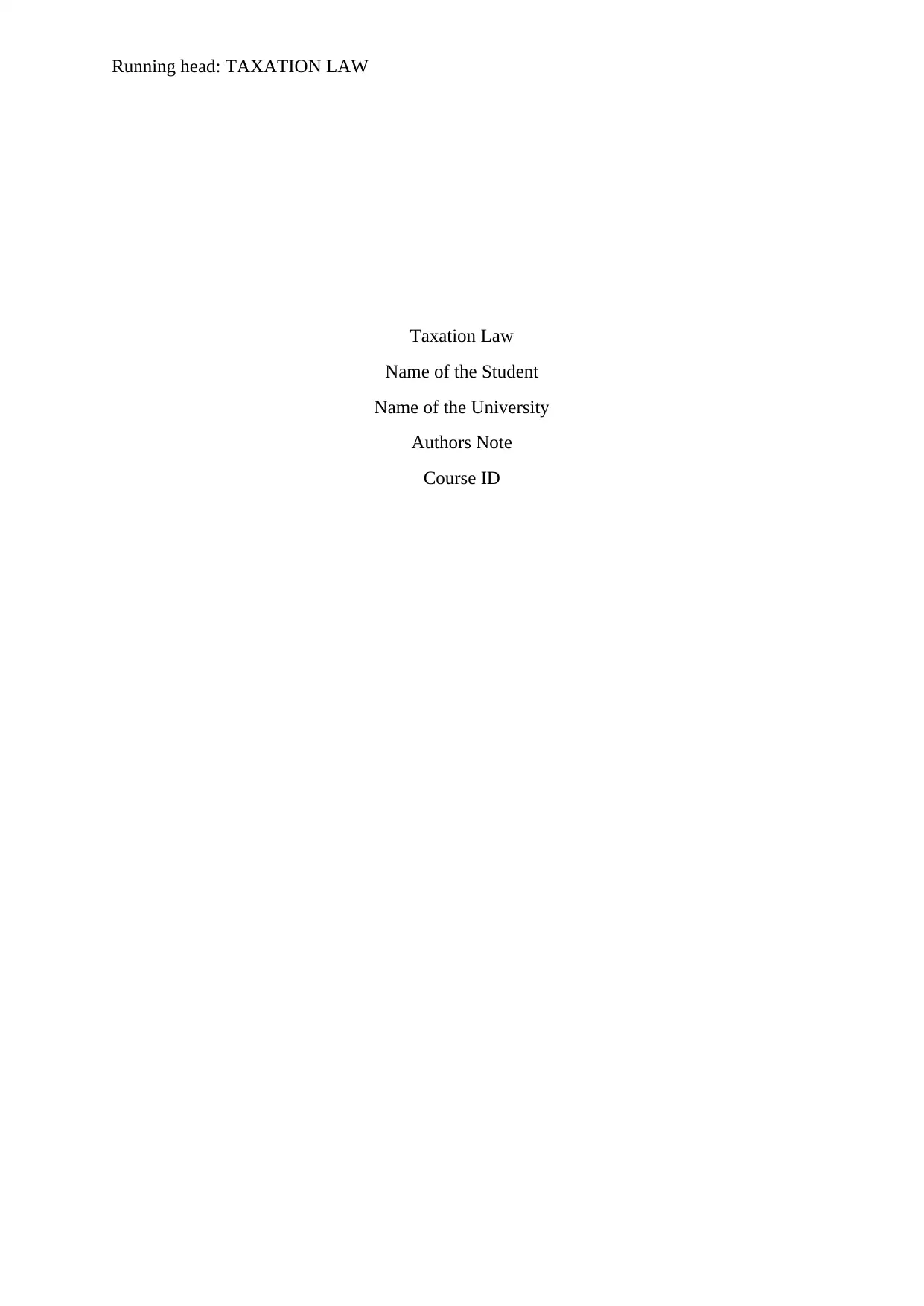
Running head: TAXATION LAW
Taxation Law
Name of the Student
Name of the University
Authors Note
Course ID
Taxation Law
Name of the Student
Name of the University
Authors Note
Course ID
Paraphrase This Document
Need a fresh take? Get an instant paraphrase of this document with our AI Paraphraser
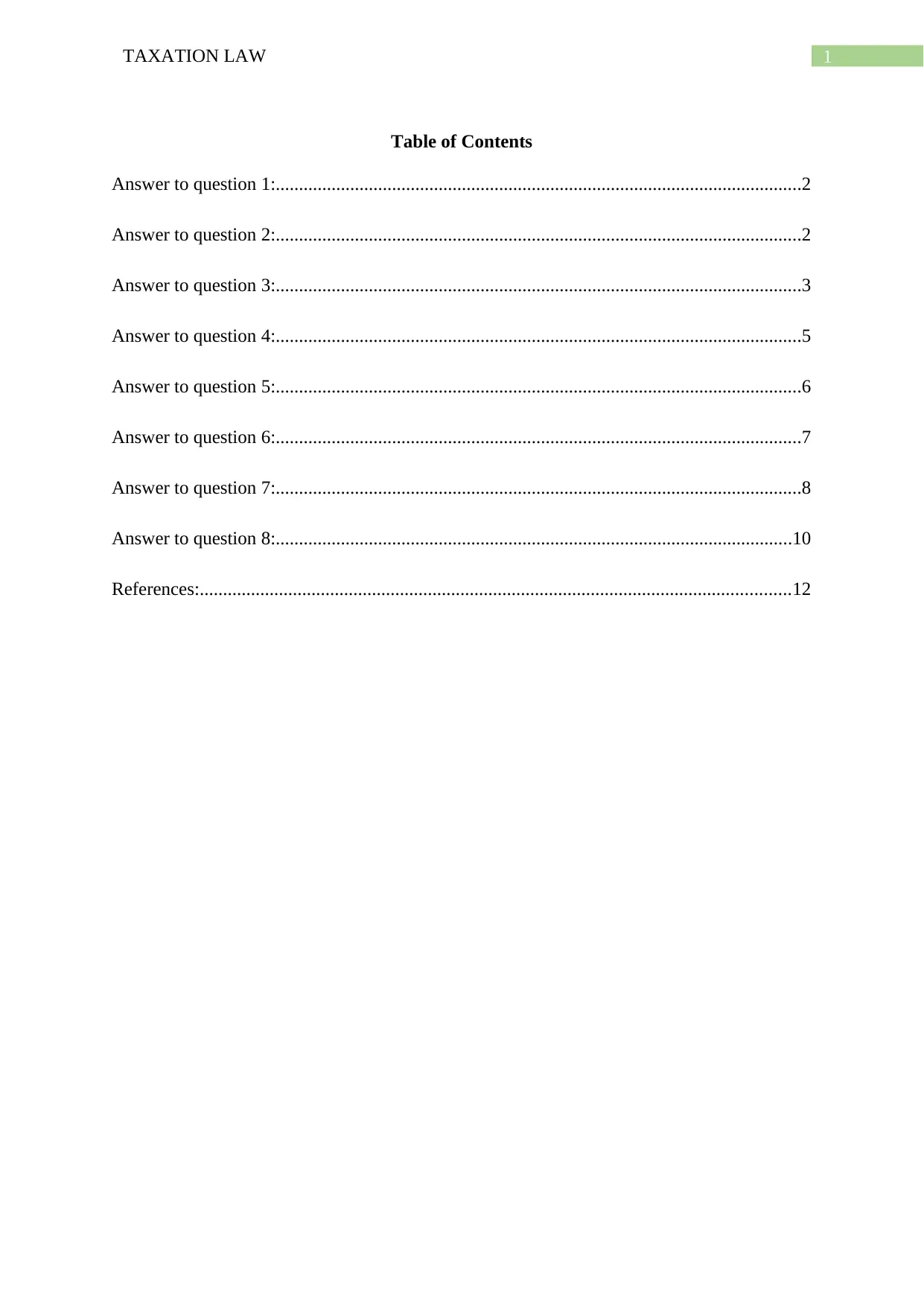
1TAXATION LAW
Table of Contents
Answer to question 1:.................................................................................................................2
Answer to question 2:.................................................................................................................2
Answer to question 3:.................................................................................................................3
Answer to question 4:.................................................................................................................5
Answer to question 5:.................................................................................................................6
Answer to question 6:.................................................................................................................7
Answer to question 7:.................................................................................................................8
Answer to question 8:...............................................................................................................10
References:...............................................................................................................................12
Table of Contents
Answer to question 1:.................................................................................................................2
Answer to question 2:.................................................................................................................2
Answer to question 3:.................................................................................................................3
Answer to question 4:.................................................................................................................5
Answer to question 5:.................................................................................................................6
Answer to question 6:.................................................................................................................7
Answer to question 7:.................................................................................................................8
Answer to question 8:...............................................................................................................10
References:...............................................................................................................................12
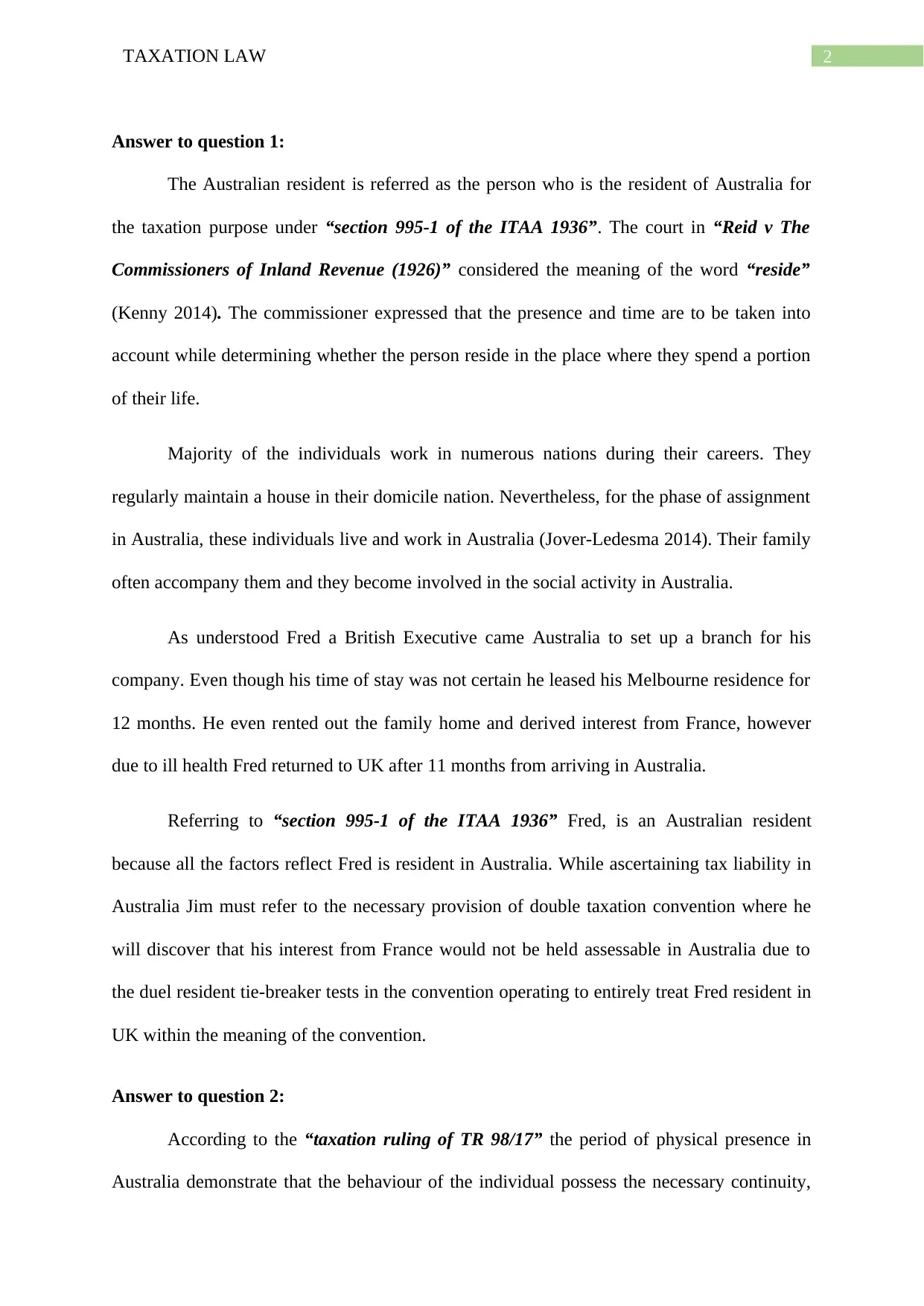
2TAXATION LAW
Answer to question 1:
The Australian resident is referred as the person who is the resident of Australia for
the taxation purpose under “section 995-1 of the ITAA 1936”. The court in “Reid v The
Commissioners of Inland Revenue (1926)” considered the meaning of the word “reside”
(Kenny 2014). The commissioner expressed that the presence and time are to be taken into
account while determining whether the person reside in the place where they spend a portion
of their life.
Majority of the individuals work in numerous nations during their careers. They
regularly maintain a house in their domicile nation. Nevertheless, for the phase of assignment
in Australia, these individuals live and work in Australia (Jover-Ledesma 2014). Their family
often accompany them and they become involved in the social activity in Australia.
As understood Fred a British Executive came Australia to set up a branch for his
company. Even though his time of stay was not certain he leased his Melbourne residence for
12 months. He even rented out the family home and derived interest from France, however
due to ill health Fred returned to UK after 11 months from arriving in Australia.
Referring to “section 995-1 of the ITAA 1936” Fred, is an Australian resident
because all the factors reflect Fred is resident in Australia. While ascertaining tax liability in
Australia Jim must refer to the necessary provision of double taxation convention where he
will discover that his interest from France would not be held assessable in Australia due to
the duel resident tie-breaker tests in the convention operating to entirely treat Fred resident in
UK within the meaning of the convention.
Answer to question 2:
According to the “taxation ruling of TR 98/17” the period of physical presence in
Australia demonstrate that the behaviour of the individual possess the necessary continuity,
Answer to question 1:
The Australian resident is referred as the person who is the resident of Australia for
the taxation purpose under “section 995-1 of the ITAA 1936”. The court in “Reid v The
Commissioners of Inland Revenue (1926)” considered the meaning of the word “reside”
(Kenny 2014). The commissioner expressed that the presence and time are to be taken into
account while determining whether the person reside in the place where they spend a portion
of their life.
Majority of the individuals work in numerous nations during their careers. They
regularly maintain a house in their domicile nation. Nevertheless, for the phase of assignment
in Australia, these individuals live and work in Australia (Jover-Ledesma 2014). Their family
often accompany them and they become involved in the social activity in Australia.
As understood Fred a British Executive came Australia to set up a branch for his
company. Even though his time of stay was not certain he leased his Melbourne residence for
12 months. He even rented out the family home and derived interest from France, however
due to ill health Fred returned to UK after 11 months from arriving in Australia.
Referring to “section 995-1 of the ITAA 1936” Fred, is an Australian resident
because all the factors reflect Fred is resident in Australia. While ascertaining tax liability in
Australia Jim must refer to the necessary provision of double taxation convention where he
will discover that his interest from France would not be held assessable in Australia due to
the duel resident tie-breaker tests in the convention operating to entirely treat Fred resident in
UK within the meaning of the convention.
Answer to question 2:
According to the “taxation ruling of TR 98/17” the period of physical presence in
Australia demonstrate that the behaviour of the individual possess the necessary continuity,
You're viewing a preview
Unlock full access by subscribing today!
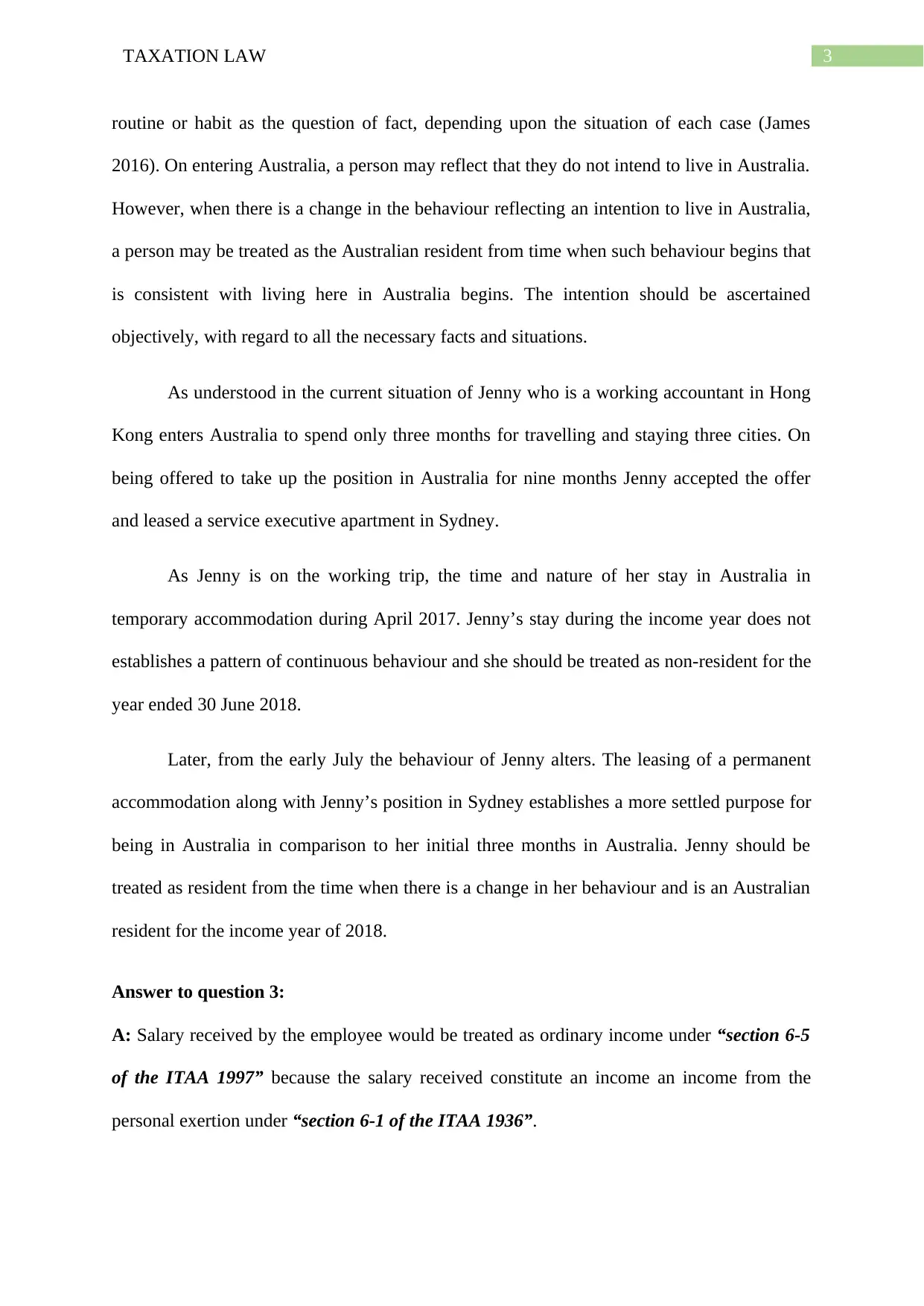
3TAXATION LAW
routine or habit as the question of fact, depending upon the situation of each case (James
2016). On entering Australia, a person may reflect that they do not intend to live in Australia.
However, when there is a change in the behaviour reflecting an intention to live in Australia,
a person may be treated as the Australian resident from time when such behaviour begins that
is consistent with living here in Australia begins. The intention should be ascertained
objectively, with regard to all the necessary facts and situations.
As understood in the current situation of Jenny who is a working accountant in Hong
Kong enters Australia to spend only three months for travelling and staying three cities. On
being offered to take up the position in Australia for nine months Jenny accepted the offer
and leased a service executive apartment in Sydney.
As Jenny is on the working trip, the time and nature of her stay in Australia in
temporary accommodation during April 2017. Jenny’s stay during the income year does not
establishes a pattern of continuous behaviour and she should be treated as non-resident for the
year ended 30 June 2018.
Later, from the early July the behaviour of Jenny alters. The leasing of a permanent
accommodation along with Jenny’s position in Sydney establishes a more settled purpose for
being in Australia in comparison to her initial three months in Australia. Jenny should be
treated as resident from the time when there is a change in her behaviour and is an Australian
resident for the income year of 2018.
Answer to question 3:
A: Salary received by the employee would be treated as ordinary income under “section 6-5
of the ITAA 1997” because the salary received constitute an income an income from the
personal exertion under “section 6-1 of the ITAA 1936”.
routine or habit as the question of fact, depending upon the situation of each case (James
2016). On entering Australia, a person may reflect that they do not intend to live in Australia.
However, when there is a change in the behaviour reflecting an intention to live in Australia,
a person may be treated as the Australian resident from time when such behaviour begins that
is consistent with living here in Australia begins. The intention should be ascertained
objectively, with regard to all the necessary facts and situations.
As understood in the current situation of Jenny who is a working accountant in Hong
Kong enters Australia to spend only three months for travelling and staying three cities. On
being offered to take up the position in Australia for nine months Jenny accepted the offer
and leased a service executive apartment in Sydney.
As Jenny is on the working trip, the time and nature of her stay in Australia in
temporary accommodation during April 2017. Jenny’s stay during the income year does not
establishes a pattern of continuous behaviour and she should be treated as non-resident for the
year ended 30 June 2018.
Later, from the early July the behaviour of Jenny alters. The leasing of a permanent
accommodation along with Jenny’s position in Sydney establishes a more settled purpose for
being in Australia in comparison to her initial three months in Australia. Jenny should be
treated as resident from the time when there is a change in her behaviour and is an Australian
resident for the income year of 2018.
Answer to question 3:
A: Salary received by the employee would be treated as ordinary income under “section 6-5
of the ITAA 1997” because the salary received constitute an income an income from the
personal exertion under “section 6-1 of the ITAA 1936”.
Paraphrase This Document
Need a fresh take? Get an instant paraphrase of this document with our AI Paraphraser
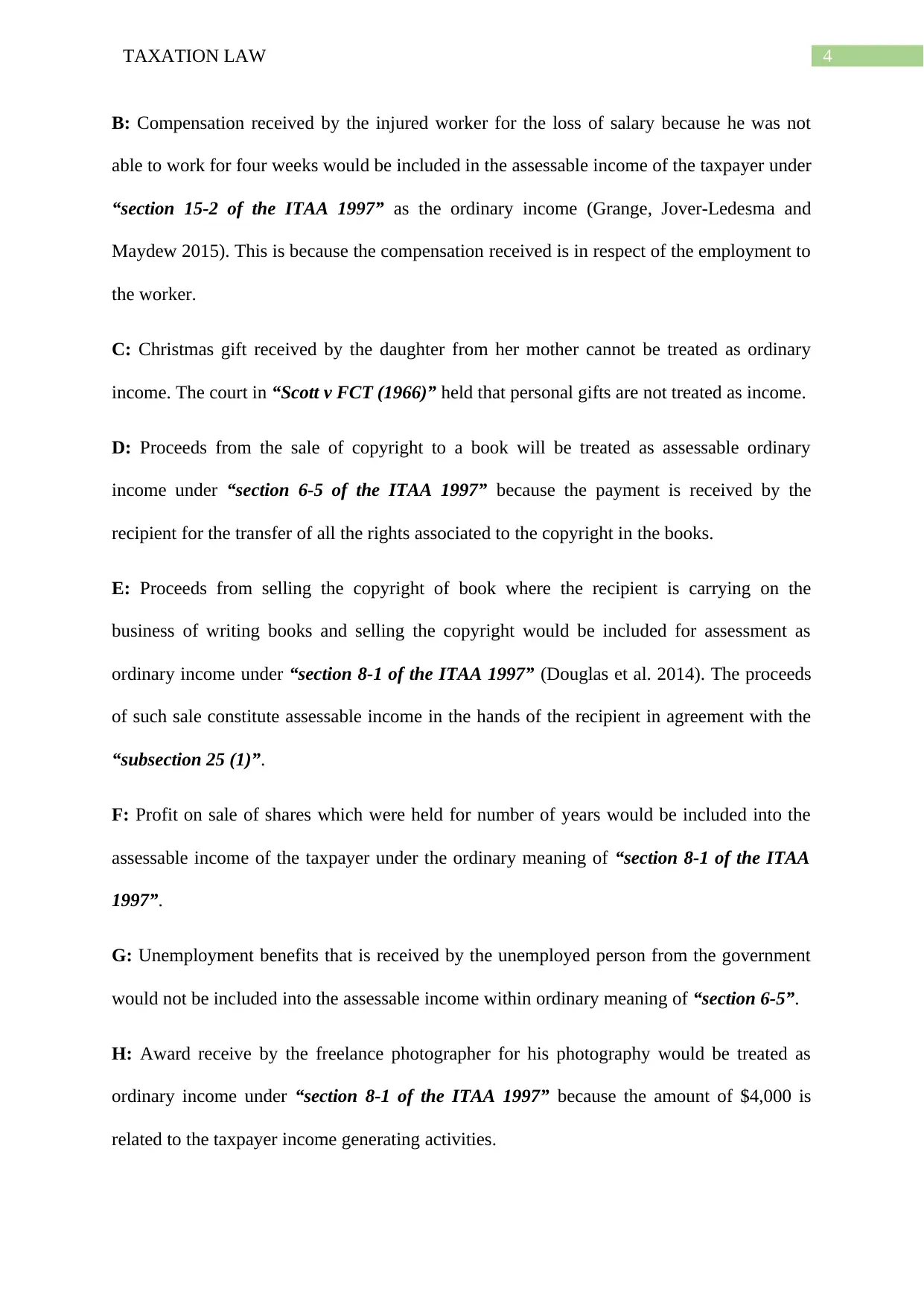
4TAXATION LAW
B: Compensation received by the injured worker for the loss of salary because he was not
able to work for four weeks would be included in the assessable income of the taxpayer under
“section 15-2 of the ITAA 1997” as the ordinary income (Grange, Jover-Ledesma and
Maydew 2015). This is because the compensation received is in respect of the employment to
the worker.
C: Christmas gift received by the daughter from her mother cannot be treated as ordinary
income. The court in “Scott v FCT (1966)” held that personal gifts are not treated as income.
D: Proceeds from the sale of copyright to a book will be treated as assessable ordinary
income under “section 6-5 of the ITAA 1997” because the payment is received by the
recipient for the transfer of all the rights associated to the copyright in the books.
E: Proceeds from selling the copyright of book where the recipient is carrying on the
business of writing books and selling the copyright would be included for assessment as
ordinary income under “section 8-1 of the ITAA 1997” (Douglas et al. 2014). The proceeds
of such sale constitute assessable income in the hands of the recipient in agreement with the
“subsection 25 (1)”.
F: Profit on sale of shares which were held for number of years would be included into the
assessable income of the taxpayer under the ordinary meaning of “section 8-1 of the ITAA
1997”.
G: Unemployment benefits that is received by the unemployed person from the government
would not be included into the assessable income within ordinary meaning of “section 6-5”.
H: Award receive by the freelance photographer for his photography would be treated as
ordinary income under “section 8-1 of the ITAA 1997” because the amount of $4,000 is
related to the taxpayer income generating activities.
B: Compensation received by the injured worker for the loss of salary because he was not
able to work for four weeks would be included in the assessable income of the taxpayer under
“section 15-2 of the ITAA 1997” as the ordinary income (Grange, Jover-Ledesma and
Maydew 2015). This is because the compensation received is in respect of the employment to
the worker.
C: Christmas gift received by the daughter from her mother cannot be treated as ordinary
income. The court in “Scott v FCT (1966)” held that personal gifts are not treated as income.
D: Proceeds from the sale of copyright to a book will be treated as assessable ordinary
income under “section 6-5 of the ITAA 1997” because the payment is received by the
recipient for the transfer of all the rights associated to the copyright in the books.
E: Proceeds from selling the copyright of book where the recipient is carrying on the
business of writing books and selling the copyright would be included for assessment as
ordinary income under “section 8-1 of the ITAA 1997” (Douglas et al. 2014). The proceeds
of such sale constitute assessable income in the hands of the recipient in agreement with the
“subsection 25 (1)”.
F: Profit on sale of shares which were held for number of years would be included into the
assessable income of the taxpayer under the ordinary meaning of “section 8-1 of the ITAA
1997”.
G: Unemployment benefits that is received by the unemployed person from the government
would not be included into the assessable income within ordinary meaning of “section 6-5”.
H: Award receive by the freelance photographer for his photography would be treated as
ordinary income under “section 8-1 of the ITAA 1997” because the amount of $4,000 is
related to the taxpayer income generating activities.
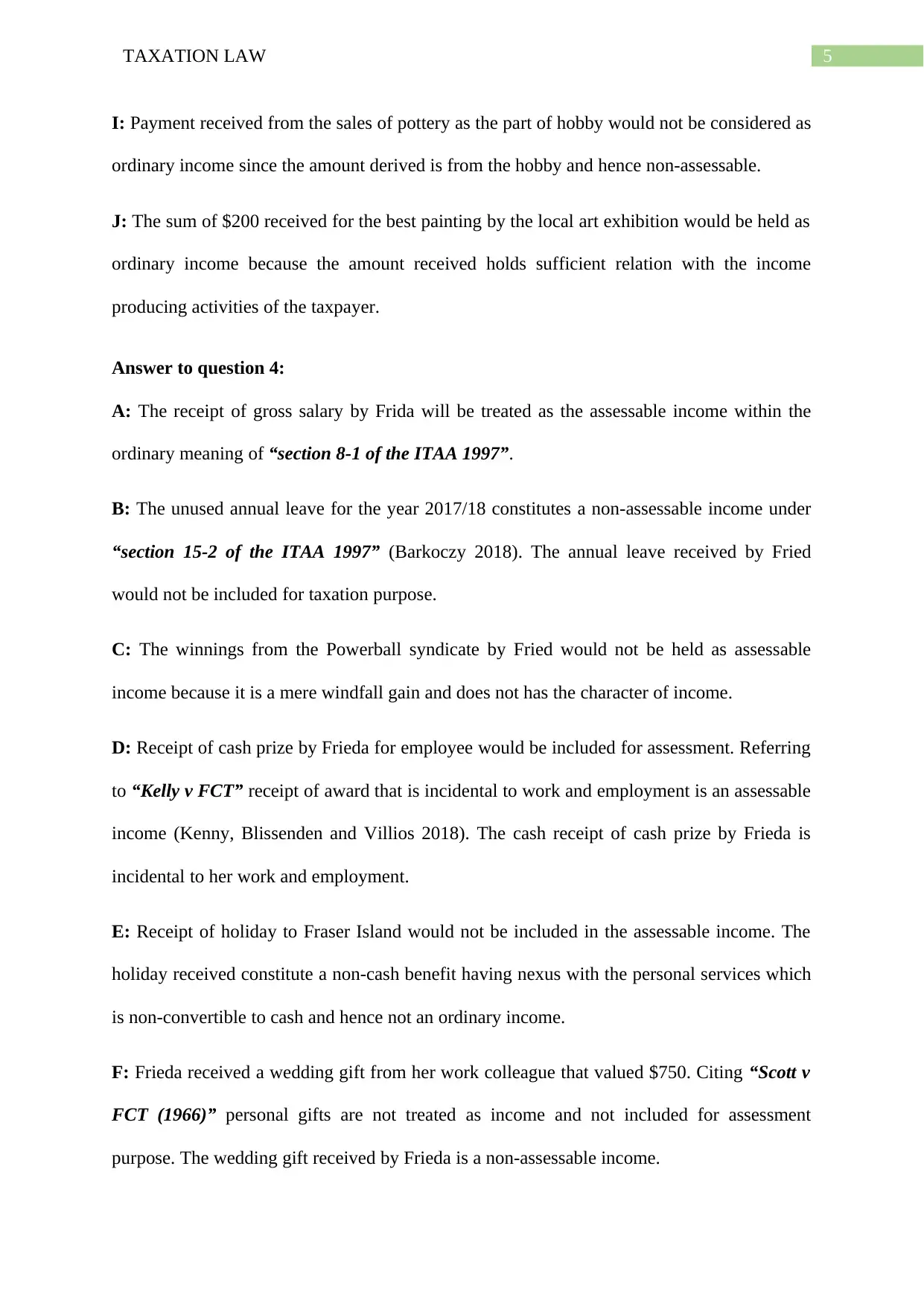
5TAXATION LAW
I: Payment received from the sales of pottery as the part of hobby would not be considered as
ordinary income since the amount derived is from the hobby and hence non-assessable.
J: The sum of $200 received for the best painting by the local art exhibition would be held as
ordinary income because the amount received holds sufficient relation with the income
producing activities of the taxpayer.
Answer to question 4:
A: The receipt of gross salary by Frida will be treated as the assessable income within the
ordinary meaning of “section 8-1 of the ITAA 1997”.
B: The unused annual leave for the year 2017/18 constitutes a non-assessable income under
“section 15-2 of the ITAA 1997” (Barkoczy 2018). The annual leave received by Fried
would not be included for taxation purpose.
C: The winnings from the Powerball syndicate by Fried would not be held as assessable
income because it is a mere windfall gain and does not has the character of income.
D: Receipt of cash prize by Frieda for employee would be included for assessment. Referring
to “Kelly v FCT” receipt of award that is incidental to work and employment is an assessable
income (Kenny, Blissenden and Villios 2018). The cash receipt of cash prize by Frieda is
incidental to her work and employment.
E: Receipt of holiday to Fraser Island would not be included in the assessable income. The
holiday received constitute a non-cash benefit having nexus with the personal services which
is non-convertible to cash and hence not an ordinary income.
F: Frieda received a wedding gift from her work colleague that valued $750. Citing “Scott v
FCT (1966)” personal gifts are not treated as income and not included for assessment
purpose. The wedding gift received by Frieda is a non-assessable income.
I: Payment received from the sales of pottery as the part of hobby would not be considered as
ordinary income since the amount derived is from the hobby and hence non-assessable.
J: The sum of $200 received for the best painting by the local art exhibition would be held as
ordinary income because the amount received holds sufficient relation with the income
producing activities of the taxpayer.
Answer to question 4:
A: The receipt of gross salary by Frida will be treated as the assessable income within the
ordinary meaning of “section 8-1 of the ITAA 1997”.
B: The unused annual leave for the year 2017/18 constitutes a non-assessable income under
“section 15-2 of the ITAA 1997” (Barkoczy 2018). The annual leave received by Fried
would not be included for taxation purpose.
C: The winnings from the Powerball syndicate by Fried would not be held as assessable
income because it is a mere windfall gain and does not has the character of income.
D: Receipt of cash prize by Frieda for employee would be included for assessment. Referring
to “Kelly v FCT” receipt of award that is incidental to work and employment is an assessable
income (Kenny, Blissenden and Villios 2018). The cash receipt of cash prize by Frieda is
incidental to her work and employment.
E: Receipt of holiday to Fraser Island would not be included in the assessable income. The
holiday received constitute a non-cash benefit having nexus with the personal services which
is non-convertible to cash and hence not an ordinary income.
F: Frieda received a wedding gift from her work colleague that valued $750. Citing “Scott v
FCT (1966)” personal gifts are not treated as income and not included for assessment
purpose. The wedding gift received by Frieda is a non-assessable income.
You're viewing a preview
Unlock full access by subscribing today!
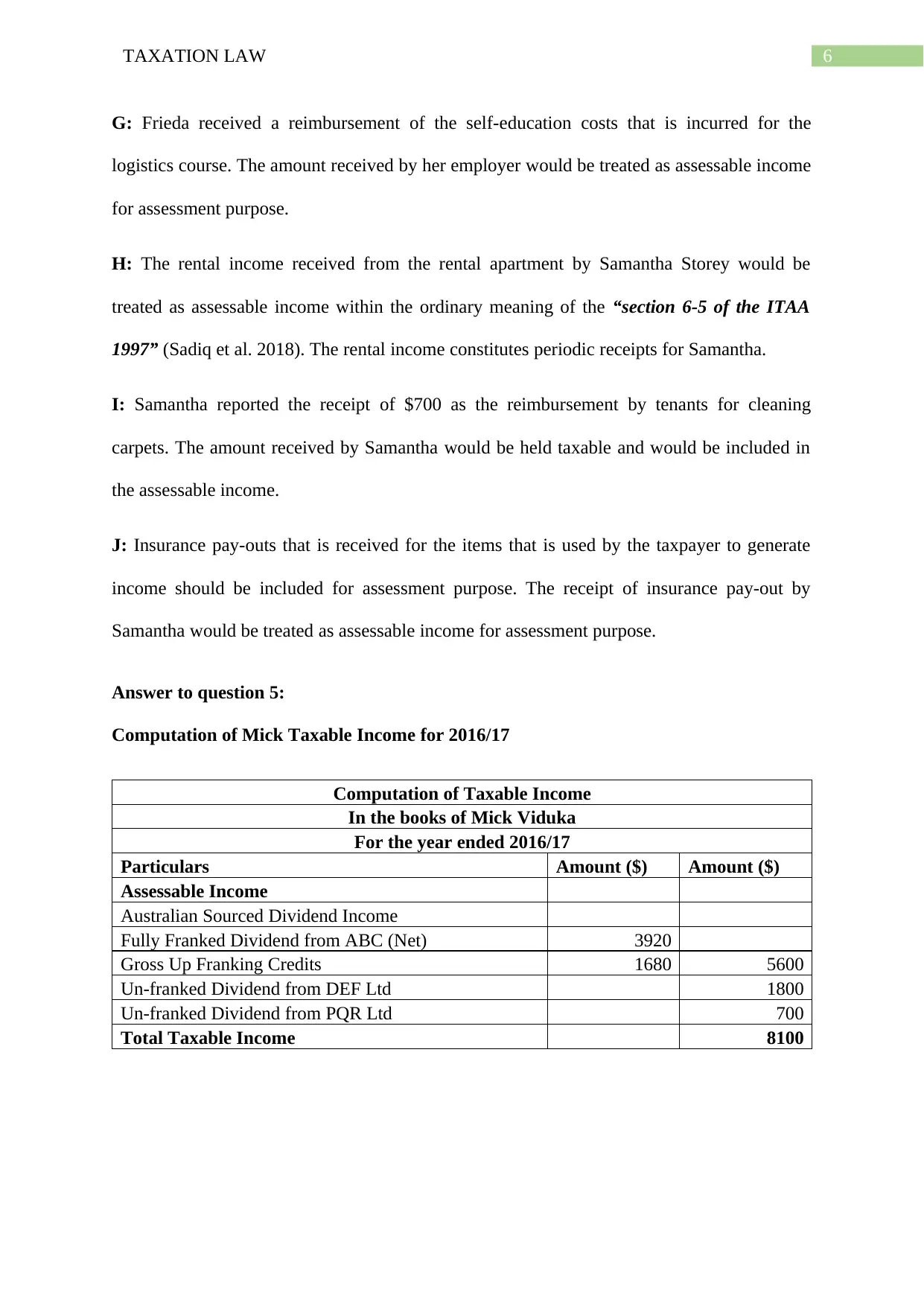
6TAXATION LAW
G: Frieda received a reimbursement of the self-education costs that is incurred for the
logistics course. The amount received by her employer would be treated as assessable income
for assessment purpose.
H: The rental income received from the rental apartment by Samantha Storey would be
treated as assessable income within the ordinary meaning of the “section 6-5 of the ITAA
1997” (Sadiq et al. 2018). The rental income constitutes periodic receipts for Samantha.
I: Samantha reported the receipt of $700 as the reimbursement by tenants for cleaning
carpets. The amount received by Samantha would be held taxable and would be included in
the assessable income.
J: Insurance pay-outs that is received for the items that is used by the taxpayer to generate
income should be included for assessment purpose. The receipt of insurance pay-out by
Samantha would be treated as assessable income for assessment purpose.
Answer to question 5:
Computation of Mick Taxable Income for 2016/17
Computation of Taxable Income
In the books of Mick Viduka
For the year ended 2016/17
Particulars Amount ($) Amount ($)
Assessable Income
Australian Sourced Dividend Income
Fully Franked Dividend from ABC (Net) 3920
Gross Up Franking Credits 1680 5600
Un-franked Dividend from DEF Ltd 1800
Un-franked Dividend from PQR Ltd 700
Total Taxable Income 8100
G: Frieda received a reimbursement of the self-education costs that is incurred for the
logistics course. The amount received by her employer would be treated as assessable income
for assessment purpose.
H: The rental income received from the rental apartment by Samantha Storey would be
treated as assessable income within the ordinary meaning of the “section 6-5 of the ITAA
1997” (Sadiq et al. 2018). The rental income constitutes periodic receipts for Samantha.
I: Samantha reported the receipt of $700 as the reimbursement by tenants for cleaning
carpets. The amount received by Samantha would be held taxable and would be included in
the assessable income.
J: Insurance pay-outs that is received for the items that is used by the taxpayer to generate
income should be included for assessment purpose. The receipt of insurance pay-out by
Samantha would be treated as assessable income for assessment purpose.
Answer to question 5:
Computation of Mick Taxable Income for 2016/17
Computation of Taxable Income
In the books of Mick Viduka
For the year ended 2016/17
Particulars Amount ($) Amount ($)
Assessable Income
Australian Sourced Dividend Income
Fully Franked Dividend from ABC (Net) 3920
Gross Up Franking Credits 1680 5600
Un-franked Dividend from DEF Ltd 1800
Un-franked Dividend from PQR Ltd 700
Total Taxable Income 8100
Paraphrase This Document
Need a fresh take? Get an instant paraphrase of this document with our AI Paraphraser
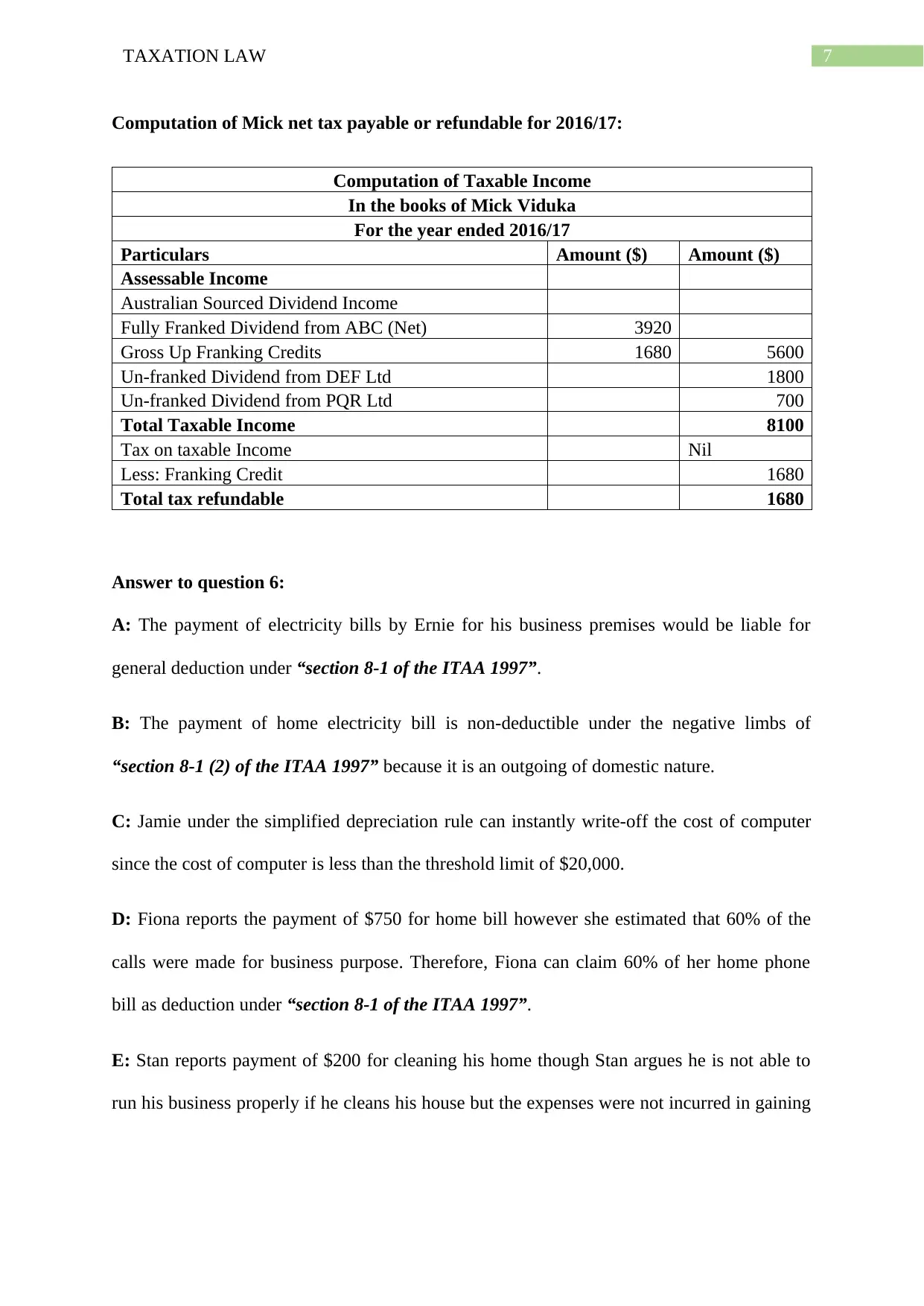
7TAXATION LAW
Computation of Mick net tax payable or refundable for 2016/17:
Computation of Taxable Income
In the books of Mick Viduka
For the year ended 2016/17
Particulars Amount ($) Amount ($)
Assessable Income
Australian Sourced Dividend Income
Fully Franked Dividend from ABC (Net) 3920
Gross Up Franking Credits 1680 5600
Un-franked Dividend from DEF Ltd 1800
Un-franked Dividend from PQR Ltd 700
Total Taxable Income 8100
Tax on taxable Income Nil
Less: Franking Credit 1680
Total tax refundable 1680
Answer to question 6:
A: The payment of electricity bills by Ernie for his business premises would be liable for
general deduction under “section 8-1 of the ITAA 1997”.
B: The payment of home electricity bill is non-deductible under the negative limbs of
“section 8-1 (2) of the ITAA 1997” because it is an outgoing of domestic nature.
C: Jamie under the simplified depreciation rule can instantly write-off the cost of computer
since the cost of computer is less than the threshold limit of $20,000.
D: Fiona reports the payment of $750 for home bill however she estimated that 60% of the
calls were made for business purpose. Therefore, Fiona can claim 60% of her home phone
bill as deduction under “section 8-1 of the ITAA 1997”.
E: Stan reports payment of $200 for cleaning his home though Stan argues he is not able to
run his business properly if he cleans his house but the expenses were not incurred in gaining
Computation of Mick net tax payable or refundable for 2016/17:
Computation of Taxable Income
In the books of Mick Viduka
For the year ended 2016/17
Particulars Amount ($) Amount ($)
Assessable Income
Australian Sourced Dividend Income
Fully Franked Dividend from ABC (Net) 3920
Gross Up Franking Credits 1680 5600
Un-franked Dividend from DEF Ltd 1800
Un-franked Dividend from PQR Ltd 700
Total Taxable Income 8100
Tax on taxable Income Nil
Less: Franking Credit 1680
Total tax refundable 1680
Answer to question 6:
A: The payment of electricity bills by Ernie for his business premises would be liable for
general deduction under “section 8-1 of the ITAA 1997”.
B: The payment of home electricity bill is non-deductible under the negative limbs of
“section 8-1 (2) of the ITAA 1997” because it is an outgoing of domestic nature.
C: Jamie under the simplified depreciation rule can instantly write-off the cost of computer
since the cost of computer is less than the threshold limit of $20,000.
D: Fiona reports the payment of $750 for home bill however she estimated that 60% of the
calls were made for business purpose. Therefore, Fiona can claim 60% of her home phone
bill as deduction under “section 8-1 of the ITAA 1997”.
E: Stan reports payment of $200 for cleaning his home though Stan argues he is not able to
run his business properly if he cleans his house but the expenses were not incurred in gaining
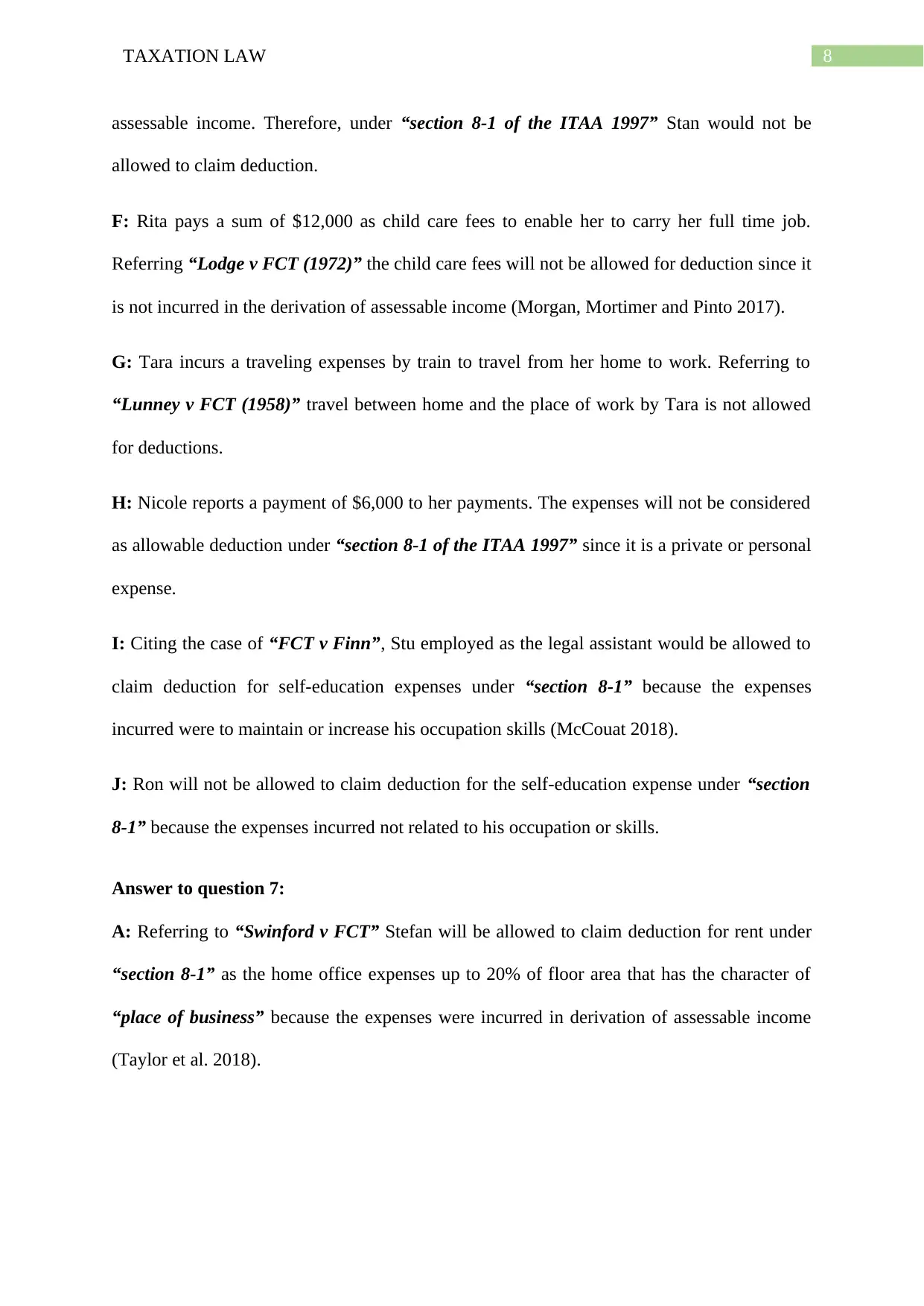
8TAXATION LAW
assessable income. Therefore, under “section 8-1 of the ITAA 1997” Stan would not be
allowed to claim deduction.
F: Rita pays a sum of $12,000 as child care fees to enable her to carry her full time job.
Referring “Lodge v FCT (1972)” the child care fees will not be allowed for deduction since it
is not incurred in the derivation of assessable income (Morgan, Mortimer and Pinto 2017).
G: Tara incurs a traveling expenses by train to travel from her home to work. Referring to
“Lunney v FCT (1958)” travel between home and the place of work by Tara is not allowed
for deductions.
H: Nicole reports a payment of $6,000 to her payments. The expenses will not be considered
as allowable deduction under “section 8-1 of the ITAA 1997” since it is a private or personal
expense.
I: Citing the case of “FCT v Finn”, Stu employed as the legal assistant would be allowed to
claim deduction for self-education expenses under “section 8-1” because the expenses
incurred were to maintain or increase his occupation skills (McCouat 2018).
J: Ron will not be allowed to claim deduction for the self-education expense under “section
8-1” because the expenses incurred not related to his occupation or skills.
Answer to question 7:
A: Referring to “Swinford v FCT” Stefan will be allowed to claim deduction for rent under
“section 8-1” as the home office expenses up to 20% of floor area that has the character of
“place of business” because the expenses were incurred in derivation of assessable income
(Taylor et al. 2018).
assessable income. Therefore, under “section 8-1 of the ITAA 1997” Stan would not be
allowed to claim deduction.
F: Rita pays a sum of $12,000 as child care fees to enable her to carry her full time job.
Referring “Lodge v FCT (1972)” the child care fees will not be allowed for deduction since it
is not incurred in the derivation of assessable income (Morgan, Mortimer and Pinto 2017).
G: Tara incurs a traveling expenses by train to travel from her home to work. Referring to
“Lunney v FCT (1958)” travel between home and the place of work by Tara is not allowed
for deductions.
H: Nicole reports a payment of $6,000 to her payments. The expenses will not be considered
as allowable deduction under “section 8-1 of the ITAA 1997” since it is a private or personal
expense.
I: Citing the case of “FCT v Finn”, Stu employed as the legal assistant would be allowed to
claim deduction for self-education expenses under “section 8-1” because the expenses
incurred were to maintain or increase his occupation skills (McCouat 2018).
J: Ron will not be allowed to claim deduction for the self-education expense under “section
8-1” because the expenses incurred not related to his occupation or skills.
Answer to question 7:
A: Referring to “Swinford v FCT” Stefan will be allowed to claim deduction for rent under
“section 8-1” as the home office expenses up to 20% of floor area that has the character of
“place of business” because the expenses were incurred in derivation of assessable income
(Taylor et al. 2018).
You're viewing a preview
Unlock full access by subscribing today!
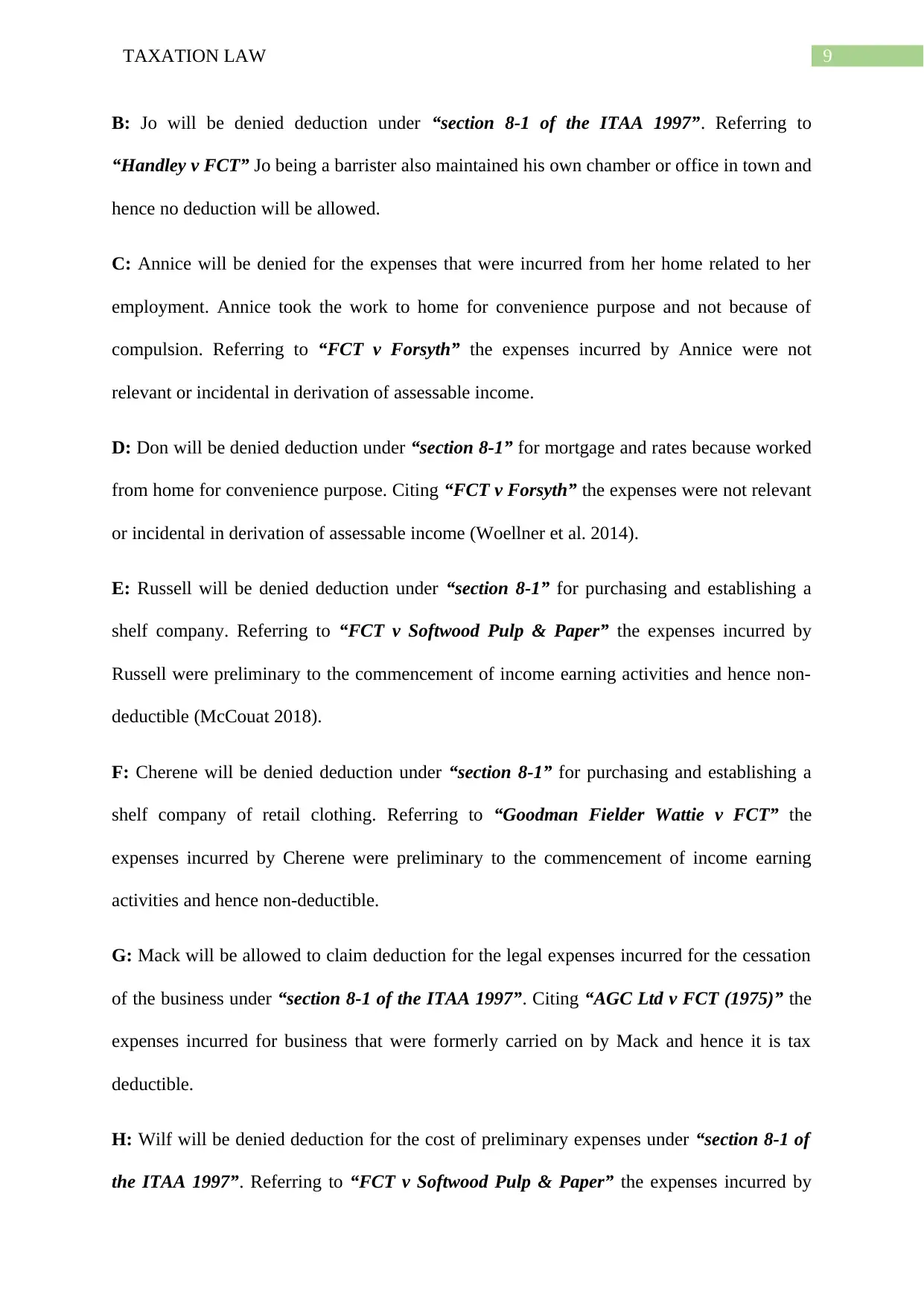
9TAXATION LAW
B: Jo will be denied deduction under “section 8-1 of the ITAA 1997”. Referring to
“Handley v FCT” Jo being a barrister also maintained his own chamber or office in town and
hence no deduction will be allowed.
C: Annice will be denied for the expenses that were incurred from her home related to her
employment. Annice took the work to home for convenience purpose and not because of
compulsion. Referring to “FCT v Forsyth” the expenses incurred by Annice were not
relevant or incidental in derivation of assessable income.
D: Don will be denied deduction under “section 8-1” for mortgage and rates because worked
from home for convenience purpose. Citing “FCT v Forsyth” the expenses were not relevant
or incidental in derivation of assessable income (Woellner et al. 2014).
E: Russell will be denied deduction under “section 8-1” for purchasing and establishing a
shelf company. Referring to “FCT v Softwood Pulp & Paper” the expenses incurred by
Russell were preliminary to the commencement of income earning activities and hence non-
deductible (McCouat 2018).
F: Cherene will be denied deduction under “section 8-1” for purchasing and establishing a
shelf company of retail clothing. Referring to “Goodman Fielder Wattie v FCT” the
expenses incurred by Cherene were preliminary to the commencement of income earning
activities and hence non-deductible.
G: Mack will be allowed to claim deduction for the legal expenses incurred for the cessation
of the business under “section 8-1 of the ITAA 1997”. Citing “AGC Ltd v FCT (1975)” the
expenses incurred for business that were formerly carried on by Mack and hence it is tax
deductible.
H: Wilf will be denied deduction for the cost of preliminary expenses under “section 8-1 of
the ITAA 1997”. Referring to “FCT v Softwood Pulp & Paper” the expenses incurred by
B: Jo will be denied deduction under “section 8-1 of the ITAA 1997”. Referring to
“Handley v FCT” Jo being a barrister also maintained his own chamber or office in town and
hence no deduction will be allowed.
C: Annice will be denied for the expenses that were incurred from her home related to her
employment. Annice took the work to home for convenience purpose and not because of
compulsion. Referring to “FCT v Forsyth” the expenses incurred by Annice were not
relevant or incidental in derivation of assessable income.
D: Don will be denied deduction under “section 8-1” for mortgage and rates because worked
from home for convenience purpose. Citing “FCT v Forsyth” the expenses were not relevant
or incidental in derivation of assessable income (Woellner et al. 2014).
E: Russell will be denied deduction under “section 8-1” for purchasing and establishing a
shelf company. Referring to “FCT v Softwood Pulp & Paper” the expenses incurred by
Russell were preliminary to the commencement of income earning activities and hence non-
deductible (McCouat 2018).
F: Cherene will be denied deduction under “section 8-1” for purchasing and establishing a
shelf company of retail clothing. Referring to “Goodman Fielder Wattie v FCT” the
expenses incurred by Cherene were preliminary to the commencement of income earning
activities and hence non-deductible.
G: Mack will be allowed to claim deduction for the legal expenses incurred for the cessation
of the business under “section 8-1 of the ITAA 1997”. Citing “AGC Ltd v FCT (1975)” the
expenses incurred for business that were formerly carried on by Mack and hence it is tax
deductible.
H: Wilf will be denied deduction for the cost of preliminary expenses under “section 8-1 of
the ITAA 1997”. Referring to “FCT v Softwood Pulp & Paper” the expenses incurred by
Paraphrase This Document
Need a fresh take? Get an instant paraphrase of this document with our AI Paraphraser
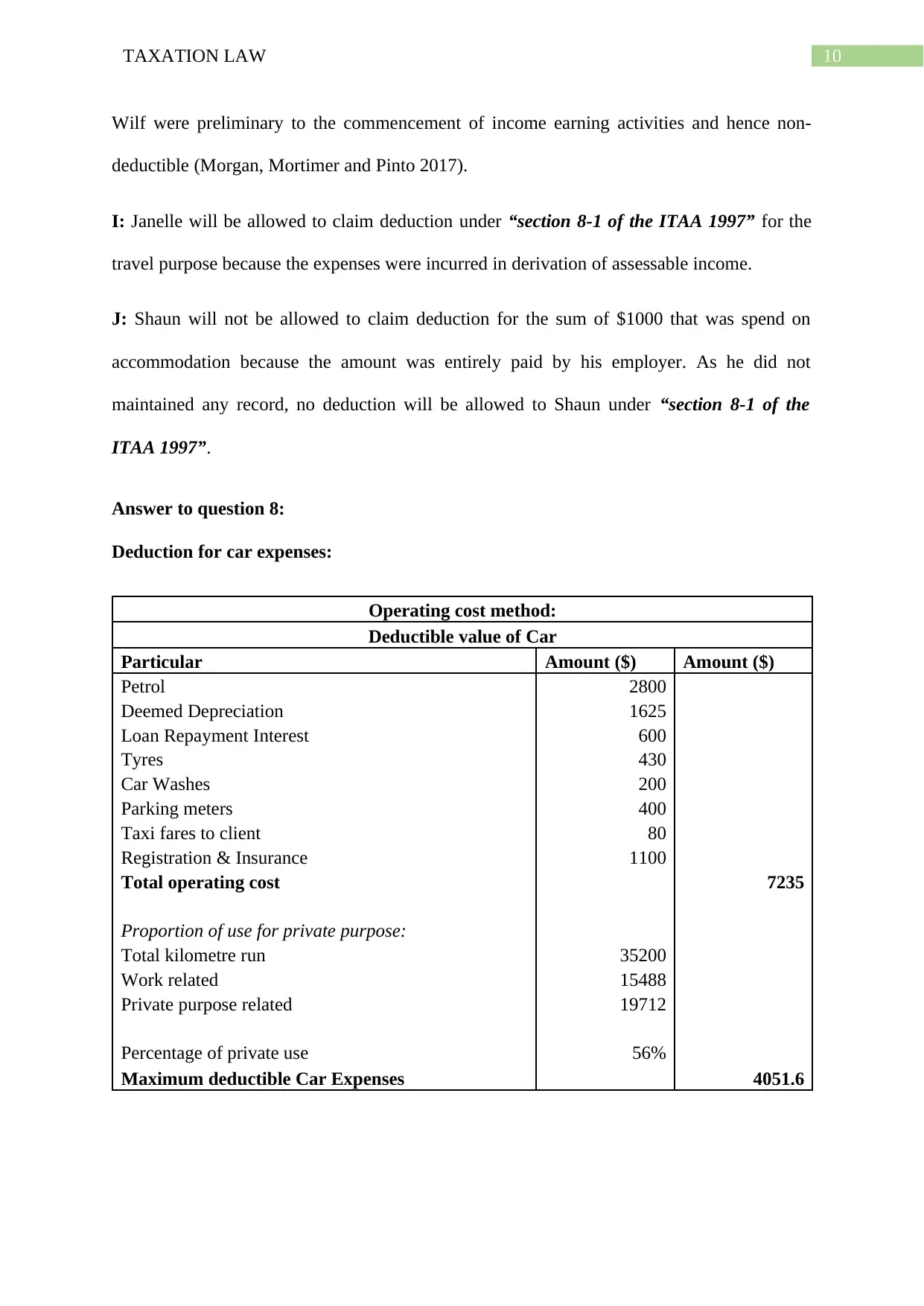
10TAXATION LAW
Wilf were preliminary to the commencement of income earning activities and hence non-
deductible (Morgan, Mortimer and Pinto 2017).
I: Janelle will be allowed to claim deduction under “section 8-1 of the ITAA 1997” for the
travel purpose because the expenses were incurred in derivation of assessable income.
J: Shaun will not be allowed to claim deduction for the sum of $1000 that was spend on
accommodation because the amount was entirely paid by his employer. As he did not
maintained any record, no deduction will be allowed to Shaun under “section 8-1 of the
ITAA 1997”.
Answer to question 8:
Deduction for car expenses:
Operating cost method:
Deductible value of Car
Particular Amount ($) Amount ($)
Petrol 2800
Deemed Depreciation 1625
Loan Repayment Interest 600
Tyres 430
Car Washes 200
Parking meters 400
Taxi fares to client 80
Registration & Insurance 1100
Total operating cost 7235
Proportion of use for private purpose:
Total kilometre run 35200
Work related 15488
Private purpose related 19712
Percentage of private use 56%
Maximum deductible Car Expenses 4051.6
Wilf were preliminary to the commencement of income earning activities and hence non-
deductible (Morgan, Mortimer and Pinto 2017).
I: Janelle will be allowed to claim deduction under “section 8-1 of the ITAA 1997” for the
travel purpose because the expenses were incurred in derivation of assessable income.
J: Shaun will not be allowed to claim deduction for the sum of $1000 that was spend on
accommodation because the amount was entirely paid by his employer. As he did not
maintained any record, no deduction will be allowed to Shaun under “section 8-1 of the
ITAA 1997”.
Answer to question 8:
Deduction for car expenses:
Operating cost method:
Deductible value of Car
Particular Amount ($) Amount ($)
Petrol 2800
Deemed Depreciation 1625
Loan Repayment Interest 600
Tyres 430
Car Washes 200
Parking meters 400
Taxi fares to client 80
Registration & Insurance 1100
Total operating cost 7235
Proportion of use for private purpose:
Total kilometre run 35200
Work related 15488
Private purpose related 19712
Percentage of private use 56%
Maximum deductible Car Expenses 4051.6
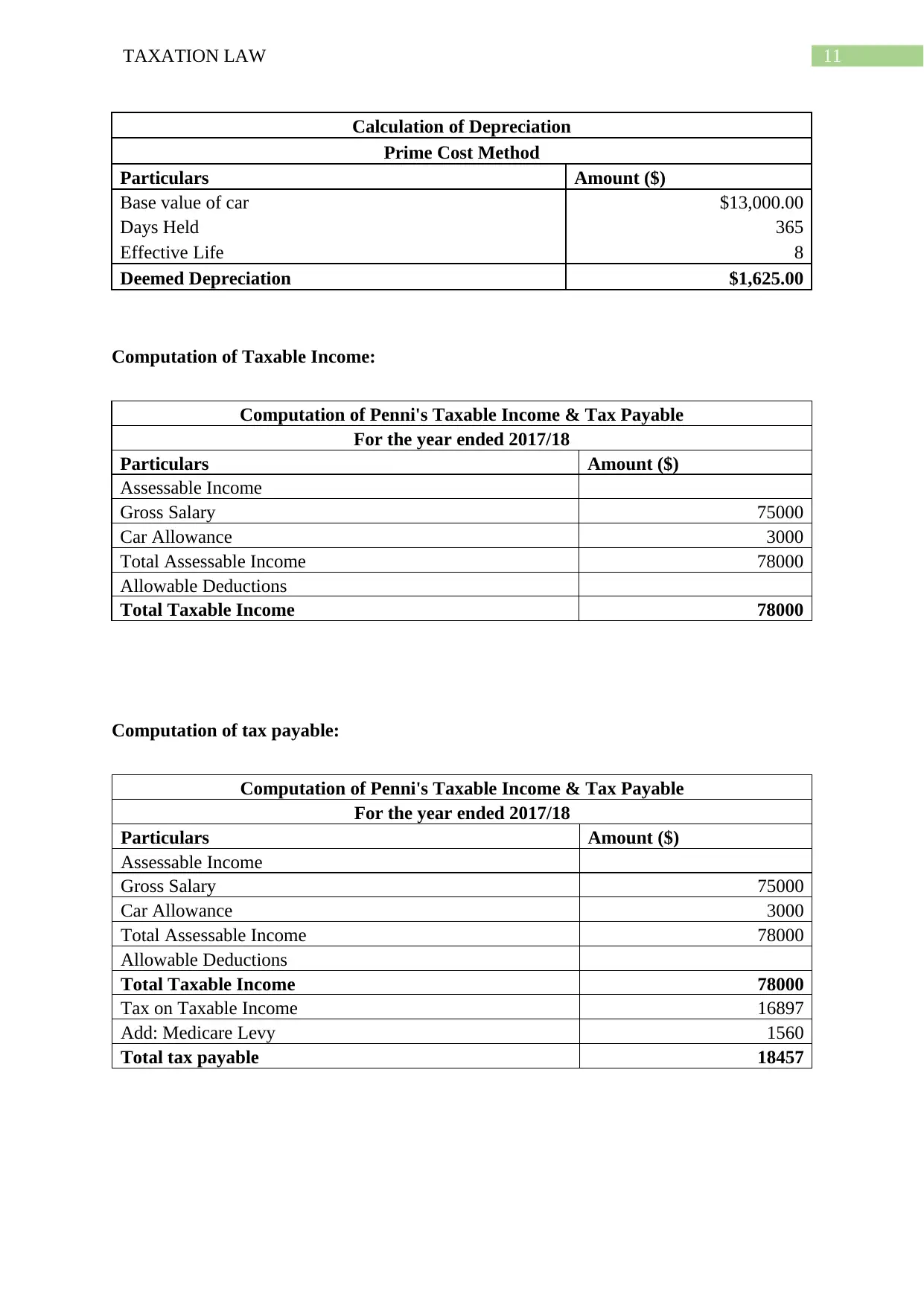
11TAXATION LAW
Calculation of Depreciation
Prime Cost Method
Particulars Amount ($)
Base value of car $13,000.00
Days Held 365
Effective Life 8
Deemed Depreciation $1,625.00
Computation of Taxable Income:
Computation of Penni's Taxable Income & Tax Payable
For the year ended 2017/18
Particulars Amount ($)
Assessable Income
Gross Salary 75000
Car Allowance 3000
Total Assessable Income 78000
Allowable Deductions
Total Taxable Income 78000
Computation of tax payable:
Computation of Penni's Taxable Income & Tax Payable
For the year ended 2017/18
Particulars Amount ($)
Assessable Income
Gross Salary 75000
Car Allowance 3000
Total Assessable Income 78000
Allowable Deductions
Total Taxable Income 78000
Tax on Taxable Income 16897
Add: Medicare Levy 1560
Total tax payable 18457
Calculation of Depreciation
Prime Cost Method
Particulars Amount ($)
Base value of car $13,000.00
Days Held 365
Effective Life 8
Deemed Depreciation $1,625.00
Computation of Taxable Income:
Computation of Penni's Taxable Income & Tax Payable
For the year ended 2017/18
Particulars Amount ($)
Assessable Income
Gross Salary 75000
Car Allowance 3000
Total Assessable Income 78000
Allowable Deductions
Total Taxable Income 78000
Computation of tax payable:
Computation of Penni's Taxable Income & Tax Payable
For the year ended 2017/18
Particulars Amount ($)
Assessable Income
Gross Salary 75000
Car Allowance 3000
Total Assessable Income 78000
Allowable Deductions
Total Taxable Income 78000
Tax on Taxable Income 16897
Add: Medicare Levy 1560
Total tax payable 18457
You're viewing a preview
Unlock full access by subscribing today!
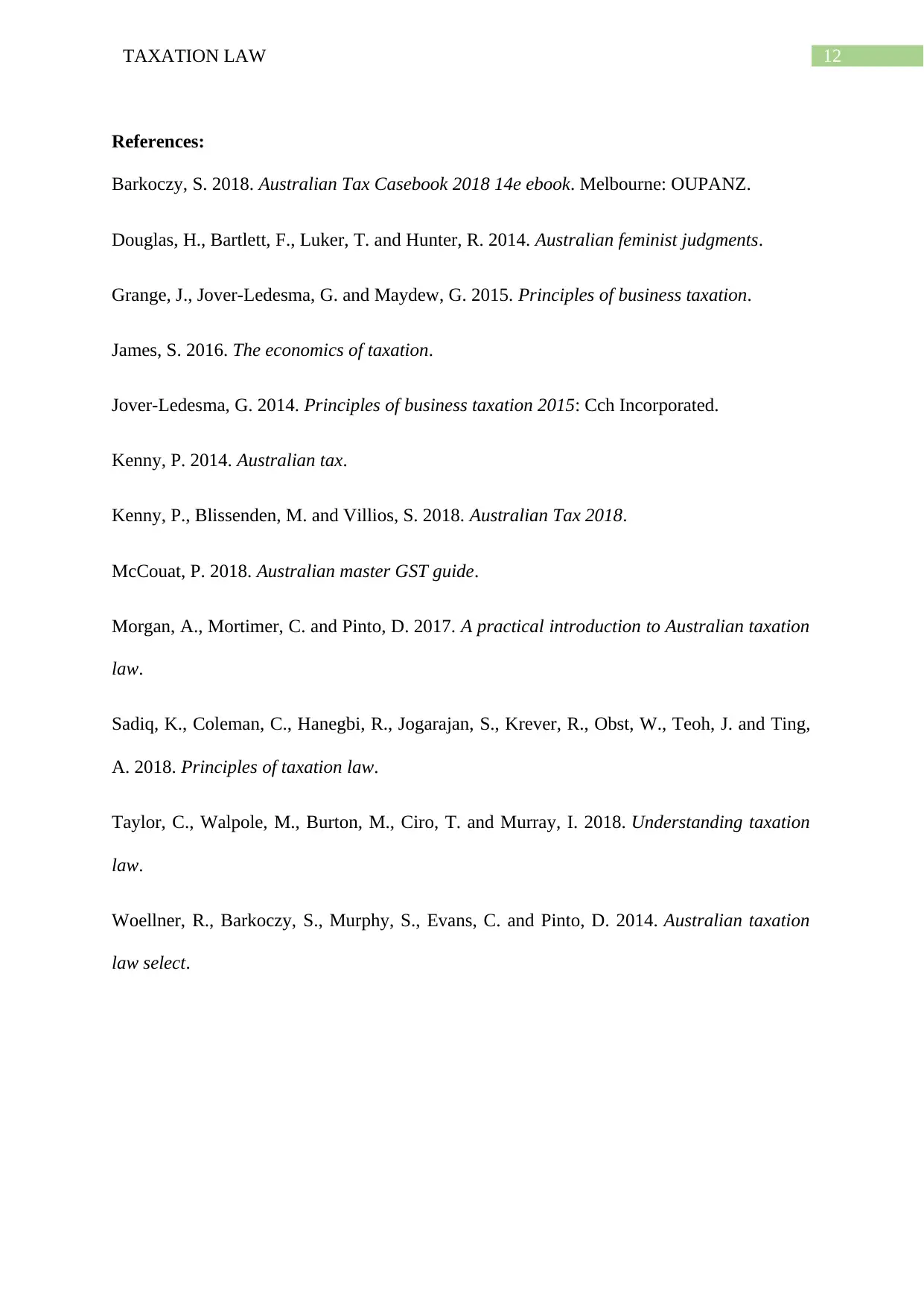
12TAXATION LAW
References:
Barkoczy, S. 2018. Australian Tax Casebook 2018 14e ebook. Melbourne: OUPANZ.
Douglas, H., Bartlett, F., Luker, T. and Hunter, R. 2014. Australian feminist judgments.
Grange, J., Jover-Ledesma, G. and Maydew, G. 2015. Principles of business taxation.
James, S. 2016. The economics of taxation.
Jover-Ledesma, G. 2014. Principles of business taxation 2015: Cch Incorporated.
Kenny, P. 2014. Australian tax.
Kenny, P., Blissenden, M. and Villios, S. 2018. Australian Tax 2018.
McCouat, P. 2018. Australian master GST guide.
Morgan, A., Mortimer, C. and Pinto, D. 2017. A practical introduction to Australian taxation
law.
Sadiq, K., Coleman, C., Hanegbi, R., Jogarajan, S., Krever, R., Obst, W., Teoh, J. and Ting,
A. 2018. Principles of taxation law.
Taylor, C., Walpole, M., Burton, M., Ciro, T. and Murray, I. 2018. Understanding taxation
law.
Woellner, R., Barkoczy, S., Murphy, S., Evans, C. and Pinto, D. 2014. Australian taxation
law select.
References:
Barkoczy, S. 2018. Australian Tax Casebook 2018 14e ebook. Melbourne: OUPANZ.
Douglas, H., Bartlett, F., Luker, T. and Hunter, R. 2014. Australian feminist judgments.
Grange, J., Jover-Ledesma, G. and Maydew, G. 2015. Principles of business taxation.
James, S. 2016. The economics of taxation.
Jover-Ledesma, G. 2014. Principles of business taxation 2015: Cch Incorporated.
Kenny, P. 2014. Australian tax.
Kenny, P., Blissenden, M. and Villios, S. 2018. Australian Tax 2018.
McCouat, P. 2018. Australian master GST guide.
Morgan, A., Mortimer, C. and Pinto, D. 2017. A practical introduction to Australian taxation
law.
Sadiq, K., Coleman, C., Hanegbi, R., Jogarajan, S., Krever, R., Obst, W., Teoh, J. and Ting,
A. 2018. Principles of taxation law.
Taylor, C., Walpole, M., Burton, M., Ciro, T. and Murray, I. 2018. Understanding taxation
law.
Woellner, R., Barkoczy, S., Murphy, S., Evans, C. and Pinto, D. 2014. Australian taxation
law select.
1 out of 13
Related Documents
Your All-in-One AI-Powered Toolkit for Academic Success.
+13062052269
info@desklib.com
Available 24*7 on WhatsApp / Email
![[object Object]](/_next/static/media/star-bottom.7253800d.svg)
Unlock your academic potential
© 2024 | Zucol Services PVT LTD | All rights reserved.





